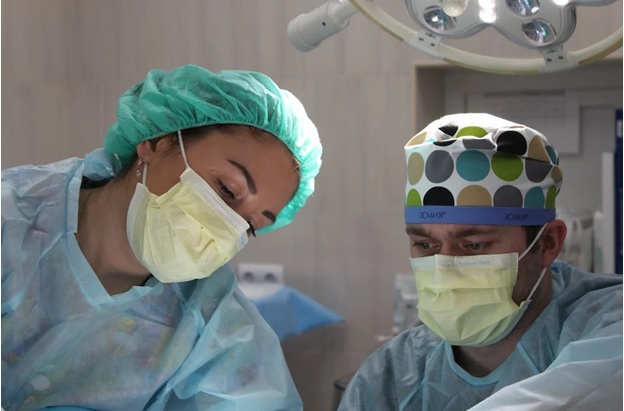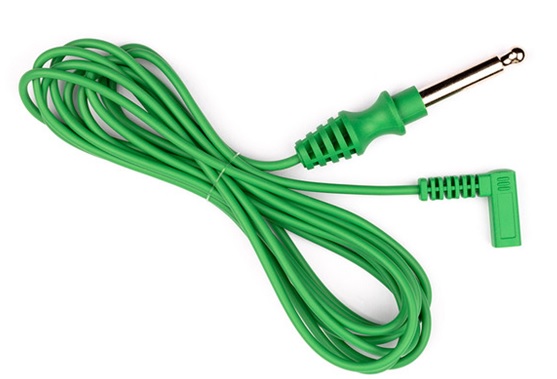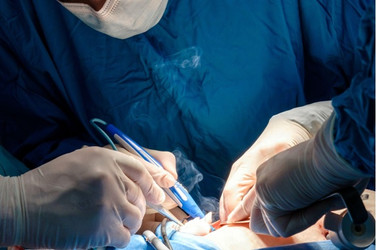To understand the critical function of electrosurgical cables, we must first understand the importance of the ESU, or electrosurgical unit.
Electrosurgical units are systems used in electrosurgery; these systems consist of an electrosurgical generator and a handpiece with a series of electrodes, connected by electrosurgical cables.
These units generate and transmit electrical energy and heat, applying it to specific tissues in an extremely precise fashion, enabling tissue dissection, ablation, electrocautery, and more.1
In electrosurgery, practice and procedure are typically categorized into either monopolar or bipolar electrosurgery.
In monopolar electrosurgery, an active electrode is placed at the site of the surgery, and the return electrode (also known as the “dispersive pad,” which safely channels current away from the patient) is placed somewhere else on the patient’s body. As the procedure is performed, current passes through the patient from the active electrode to the return electrode.
In bipolar electrosurgery, the active and return electrodes are both placed at the site of the surgery. A pair of forceps is used for the procedure, and the two tips of the forceps serve as the two electrodes required. Only the tissue grasped in the forceps is affected in the procedure and included in the circuit. Because bipolar electrosurgery permits coagulation, it is sometimes referred to as “wet field” cautery.
Preparing for the electrosurgical procedure may hinge on its specific objectives, but best practices indicate that the patient’s skin surrounding the procedure site should be treated with an antiseptic such as chlorhexidine. Alcohol should be avoided; if it is used it must be allowed to dry completely before proceeding as alcohol presents a risk of ignition in the presence of heat generated by the current carried by the electrosurgical cables.
Consequently, electrosurgery units should never be used in the presence of flammable substances, and the handpiece should also be kept in the nonconductive holster when it is not in use.
Burns can also be caused by the electrosurgical cables if they are handled carelessly. They should never be wrapped around metal instruments; the current can pass through the cable to the instrument, causing burns.
The electrosurgical cables should also never be attached to drapes with metal clips, as the current can pass through the clip and ignite any textiles with which it is in contact.1 Metal clips can also damage electrosurgical cables over time. Additionally, wrapping one of the electrosurgical cables around a piece of metal (a bar, a clip, or otherwise) creates a transformer; this can adversely impact the operating voltage and can cause fires.
As with any surgical procedure, success arises in part from both training and the use of high-quality medical or electrical equipment.

The electrosurgical cables themselves, while perhaps an overlooked component of the ESU, are nonetheless critical to the success and safe operation of the procedure. They carry power and information between the generator and other components of the system.
At LifeSync Neuro, we carry a wide range of disposable and reusable electrosurgical cables, for both monopolar and bipolar electrosurgery. As with our other leadwires and medical monitoring equipment, we place the highest possible emphasis on cost efficiency, quality assurance, standardization, and process efficiency.
Disposable and Reusable Monopolar and Bipolar Electrosurgical Cables

At LifeSync, carry disposable monopolar electrosurgical cables from our own American Biosurgical and LifeSync branded options.
Our electrosurgical cables are available in both sterile and non-sterile configurations, with both straight and 90° connections. The American Biosurgical cables we carry are made using high-quality materials and insulation such as thermoplastic rubber (TPR), silicone, polypropylene (PP), and polyethylene (PE).
These electrosurgical cables round out our catalog of high-quality medical monitoring equipment.
Cost-Effective, Quality-Assured, Process-Boosting Standardization
LifeSync Neuro, formerly Advantage Medical Cables (AMC) is the industry’s leading name in patient monitoring. We produce a wide range of ECG, EEG and EMG leadwires and electrosurgical cables that deliver excellent value, radiolucency, and high signal quality.
LifeSync’s medical monitoring equipment is priced competitively, enabling you to enjoy the highest quality at the same time as attractive prices, industry leading warranties, and top-tier customer care and support.
We further support our clients by simplifying ordering by improving standardization efforts, thereby enabling our partners to streamline partner, order, and inventory management.
Through discovery, evaluation and conversion, LifeSync keeps an emphasis on customer devotion, and supplies the highest-quality ECG and EEG leadwires, electrosurgical cables, trunk cables, SpO2 sensors, NIBP cuffs, and other medical equipment to our clients.
For more information on our industry-leading products, please consult our entire collection via the previous link, or feel free to speak to a LifeSync expert who can help you find what you need. We’re here to help!
References
- Cordero I. Electrosurgical units - how they work and how to use them safely. Community Eye Health. 2015;28(89):15-6. PMID: 26435589; PMCID: PMC4579996.
- Vo A, Bengezi O. Third-degree burns caused by ignition of chlorhexidine: A case report and systematic review of the literature. Plast Surg (Oakv). 2014 Winter;22(4):264-6. doi: 10.4172/plastic-surgery.1000893. PMID: 25535466; PMCID: PMC4271757.

